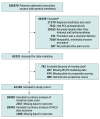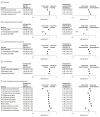Association of Intraoperative Opioid Administration With Postoperative Pain and Opioid Use
- PMID: 37314800
- PMCID: PMC10267849
- DOI: 10.1001/jamasurg.2023.2009
Association of Intraoperative Opioid Administration With Postoperative Pain and Opioid Use
Abstract
Importance: Opioids administered to treat postsurgical pain are a major contributor to the opioid crisis, leading to chronic use in a considerable proportion of patients. Initiatives promoting opioid-free or opioid-sparing modalities of perioperative pain management have led to reduced opioid administration in the operating room, but this reduction could have unforeseen detrimental effects in terms of postoperative pain outcomes, as the relationship between intraoperative opioid usage and later opioid requirements is not well understood.
Objective: To characterize the association between intraoperative opioid usage and postoperative pain and opioid requirements.
Design, setting, and participants: This retrospective cohort study evaluated electronic health record data from a quaternary care academic medical center (Massachusetts General Hospital) for adult patients who underwent noncardiac surgery with general anesthesia from April 2016 to March 2020. Patients who underwent cesarean surgery, received regional anesthesia, received opioids other than fentanyl or hydromorphone, were admitted to the intensive care unit, or who died intraoperatively were excluded. Statistical models were fitted on the propensity weighted data set to characterize the effect of intraoperative opioid exposures on primary and secondary outcomes. Data were analyzed from December 2021 to October 2022.
Exposures: Intraoperative fentanyl and intraoperative hydromorphone average effect site concentration estimated using pharmacokinetic/pharmacodynamic models.
Main outcomes and measures: The primary study outcomes were the maximal pain score during the postanesthesia care unit (PACU) stay and the cumulative opioid dose, quantified in morphine milligram equivalents (MME), administered during the PACU stay. Medium- and long-term outcomes associated with pain and opioid dependence were also evaluated.
Results: The study cohort included a total of 61 249 individuals undergoing surgery (mean [SD] age, 55.44 [17.08] years; 32 778 [53.5%] female). Increased intraoperative fentanyl and intraoperative hydromorphone were both associated with reduced maximum pain scores in the PACU. Both exposures were also associated with a reduced probability and reduced total dosage of opioid administration in the PACU. In particular, increased fentanyl administration was associated with lower frequency of uncontrolled pain; a decrease in new chronic pain diagnoses reported at 3 months; fewer opioid prescriptions at 30, 90, and 180 days; and decreased new persistent opioid use, without significant increases in adverse effects.
Conclusions and relevance: Contrary to prevailing trends, reduced opioid administration during surgery may have the unintended outcome of increasing postoperative pain and opioid consumption. Conversely, improvements in long-term outcomes might be achieved by optimizing opioid administration during surgery.
Conflict of interest statement
Figures



References
-
- Maclean JC, Mallatt J, Ruhm CJ, Simon K. Economic studies on the opioid crisis: a review. Published November 2020. doi:10.3386/w28067 - DOI
-
- Substance Abuse Mental Health Services Administration . Key Substance Use and Mental Health Indicators in the United States: Results from the 2017 National Survey on Drug Use and Health. National Survey on Drug Use and Health; 2018.
-
- US Centers for Disease Control and Prevention . Data Overview—Opioids. Accessed September 21, 2022. https://www.cdc.gov/opioids/data/index.html
Publication types
MeSH terms
Substances
Grants and funding
LinkOut - more resources
Full Text Sources
Medical
Miscellaneous

